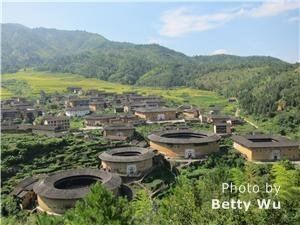Prefecture-level city Longyan Area 2,216 km² | Time zone China Standard (UTC+8) Province Fujian | |
 | ||
Country People's Republic of China Points of interest Chuxi tulou group, Chengqilou, Yongding earth buildings, Qiaofulou, Hongkeng Earthen Folk Cult | ||
Tulou hakka earth buildings village at yongding china
Yongding (Chinese: 永定) is a district under the jurisdiction of Longyan prefecture-level city in the southwest of Fujian Province, People's Republic of China. It is the home of many Hakka-speaking families. Yongding has a population of about 400,000, of which more than 99% are Hakka, the rest being Southern Min-speaking people. It was reported at the end of 2014 that Yongding had become a district, having previously been a county.
Contents
- Tulou hakka earth buildings village at yongding china
- Map of Yongding Longyan Fujian China
- Hakka tulou yongding fujian china
- Situation
- Administration
- Towns
- Townships
- Culture
- Economy
- Miscellaneous
- References
Map of Yongding, Longyan, Fujian, China
Hakka tulou yongding fujian china
Situation
Yongding county is situated on the Fujian-Guangdong border. Shanghang County to the northwest and Longyan centre to the northeast are in Longyan; Nanjing County to the east and Pinghe County to the southeast are in Zhangzhou. To the southwest lies Dabu County of Meizhou, GD. Both Dabu and Shanghang are Hakka-speaking counties; Longyan Centre, Nanjing and Pinghe are predominantly Minnan-speaking.
Yongding is about 2,500 km2 (970 sq mi) in area. Like other counties of Fujian province, Yongding is 80% hills and mountains, 10% water or rivers, and 10% fields. Two major rivers run through the county: Yongding River (永定河) and Xiayang Creek (下洋溪). Both are tributaries of the Ting River (汀江, the name by which it is known in Fujian territory) or Han River (韩江, the name by which it is known in Guangdong province). Located in a sub-tropical area and subject to typhoons, Yongding has high annual precipitation of about 1,200 to 1,500 millimetres (47 to 59 in) per year.
Administration
As all counties, Yongding County is divided into township-level units, i.e. towns and townships.
The county executive, legislature and judiciary are in Fengcheng Town (凤城镇), together with the CPC and PSB branches.
Towns
Besides Fengcheng, there are nine other towns :
Townships
There are fourteen townships :
Culture
Yongding County is famous for its tulou, large multi-family adobe buildings. Out of the 10 tulous or tulous clusters inscribed on the World Heritage List (as Fujian Tulou), 5 are within Yongding County:
Economy
As a result of abundant precipitation and mountainous terrain, hydroelectric power is abundant. There are numerous hydro plants in the county, one notable one being the provincial Mianhuatan Hydroelectric Power Station. The plant has a water storage capacity of 2.035 billion cubic meters and is able to generate 1.52 billion kilowatt hours of electricity a year. The Mianhuatan hydrodam contributes greatly to the rapidly growing economy of Fujian and neighboring Guangdong province.
In agriculture, rice is the main crop for the county. Most low-lying fields can yield two rice crops per year, while in high land fields, because of the earlier frost, only one harvest can be assured.
Yongding is an important tobacco producer. The cultivation of tobacco started in Wan Li era of the Ming Dynasty. Yongding was honored as the "home of tobacco" in the early 20th century. Although its significance has declined in recent years, Yongding is still one of the most important tobacco producing areas in the region. Many top brand Chinese cigarettes contain Yongding leaf.
Yongding is rich in mineral deposits, most notably coal. Most of the county's coal is shipped to Guangdong, where economic growth has created huge demand for energy. This in turn has created demand for heavy trucks. As a result, Yongding is one of the top counties for the number of trucks.
Miscellaneous
There have been many famous overseas Chinese with their roots in Yongding. Aw Boon-Haw (胡文虎) was one of the most famous overseas Chinese in the 1930s and 40s.
